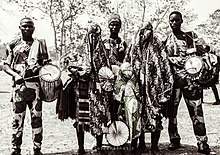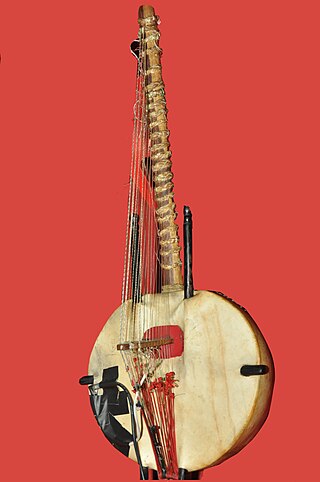
The kora is a stringed instrument used extensively in West Africa. A kora typically has 21 strings, which are played by plucking with the fingers. It has features of the lute and harp.
Given the vastness of the African continent, its music is diverse, with regions and nations having many distinct musical traditions. African music includes the genres makwaya, highlife, mbube, township music, jùjú, fuji, jaiva, afrobeat, afrofusion, mbalax, Congolese rumba, soukous, ndombolo, makossa, kizomba, taarab and others. African music also uses a large variety of instruments from all across the continent. The music and dance of the African diaspora, formed to varying degrees on African musical traditions, include American music like Dixieland jazz, blues, jazz, and many Caribbean genres, such as calypso and soca. Latin American music genres such as cumbia, salsa music, son cubano, rumba, conga, bomba, samba and zouk were founded on the music of enslaved Africans, and have in turn influenced African popular music.

The balafon is a gourd-resonated xylophone, a type of struck idiophone. It is closely associated with the neighbouring Mandé, Bwaba Bobo, Senoufo and Gur peoples of West Africa, particularly the Guinean branch of the Mandinka ethnic group, but is now found across West Africa from Guinea, Burkina Faso, Mali. Its common name, balafon, is likely a European coinage combining its Mandinka name ߓߟߊ bala with the word ߝߐ߲ fôn 'to speak' or the Greek root phono.
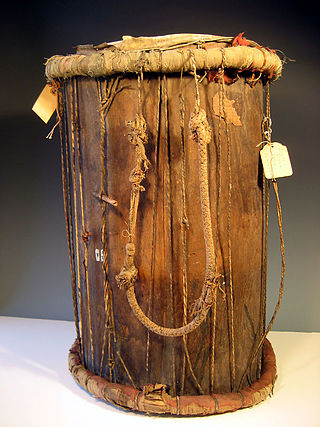
Senegal's music is best known abroad due to the popularity of mbalax, a development of conservative music from different ethnic groups and sabar drumming popularized internationally by Youssou N'Dour.
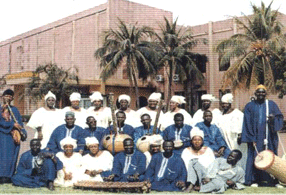
The music of Mali is, like that of most West African nations, ethnically diverse, but one influence predominates: that of the ancient Mali Empire of the Mandinka. Mande people make up around 50% of Mali's population; other ethnic groups include the Fula (17%), Gur-speakers 12%, Songhai people (6%), Tuareg and Moors (10%).

The music of Burkina Faso includes the folk music of 60 different ethnic groups. The Mossi people, centrally located around the capital, Ouagadougou, account for 40% of the population while, to the south, Gurunsi, Gurma, Dagaaba and Lobi populations, speaking Gur languages closely related to the Mossi language, extend into the coastal states. In the north and east the Fulani of the Sahel preponderate, while in the south and west the Mande languages are common; Samo, Bissa, Bobo, Senufo and Marka. Burkinabé traditional music has continued to thrive and musical output remains quite diverse. Popular music is mostly in French: Burkina Faso has yet to produce a major pan-African success.

A griot is a West African historian, storyteller, praise singer, poet, and/or musician.

The music of the Gambia is closely linked musically with that of its neighbor, Senegal, which surrounds its inland frontiers completely. Among its prominent musicians is Foday Musa Suso. Mbalax is a widely known popular dance music of the Gambia and neighbouring Senegal. It fuses popular Western music and dance, with sabar, the traditional drumming and dance music of the Wolof and Serer people.

Xalam is a traditional lute from West Africa with 1 to 5 strings. The xalam is commonly played in Mali, Gambia, Senegal, Niger, Northern Nigeria, Northern Ghana, Burkina Faso, Mauritania, and Western Sahara. The xalam and its variants are known by various names in other languages, including bappe, diassare, hoddu (Pulaar), koliko (Gurunsi), kologo (Frafra), komsa, kontigi, gurmi, garaya (Hausa), koni, konting (Mandinka), molo (Songhay/Zarma), ndere, ngoni (Bambara), and tidinit.

The Wolof, the largest ethnic group in Senegal, have a distinctive musical tradition that, along with the influence of neighboring Fulani, Tukulor, Serer, Jola, and Malinke cultures, has contributed greatly to popular Senegalese music, and to West African music in general. Wolof music takes its roots from the Serer musical tradition, particularly from the Serer pre-colonial Kingdom of Saloum. Virtually all Wolof musical terminology including musical instruments comes from the Serer language.
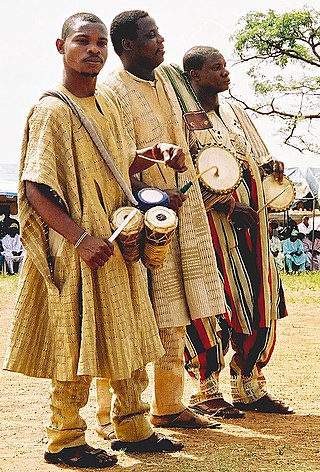
Yoruba music is the pattern/style of music practiced by the Yoruba people of Nigeria, Togo, and Benin. It is perhaps best known for its extremely advanced drumming tradition and techniques, especially using the gongon hourglass shape tension drums. Yoruba folk music became perhaps the most prominent kind of West African music in Afro-Latin and Caribbean musical styles; it left an especially important influence on the music used in Santería practice and the music of Cuba.
Afro rock is a style of rock music with African influences. Afro rock is a dynamic interplay between Western rock music and African musical elements such as rhythm, melodies and instrumentation. Afro rock bands and artists in the late 1960s and early 1970s included Osibisa, Assagai and Lafayette Afro Rock Band.
Alhaji Bai Konte (1920–1983) was a jali from Brikama, Gambia. His grandfather, Jali Ndaba Konteh, was a Konting player who originally brought his family to Brikama from the Kankaba region of Mali. Bai Konte's father, Burama Konte, was also a celebrated kora player and composed several important pieces in the repertoire. Burama Konte, composed the anthem of the 19th century Senegambian hero Mansumaneh Yundum, Yundum N'ko. It was from that piece that the anthems of Sheriff Sidi Hydara and Nyansu Mbasse originated. Burama Konteh was a well-known kora player of his generation. Bai Konte was a regular on Radio Gambia and Radio Senegal's joint program called Chossani Senegambia in the 1970s. He and other griots such as Jali Nyama Suso and Alhaji Abdoulaye Samba used to play live music during the show. Bai Konteh had narrated many epics on that show including the epic of King Abdou Njie and his griot and advisor Ibra Faye. Prominent broadcasters of that show included Alhaji Alieu Ebrima Cham Joof, Alhaji Assan Njie and Alhaji Mansour Njie.
Mbalax is the urban dance music of Senegal and the Gambia. The musical style is rooted in the indigenous instrumental and vocal styles accompanied by polyrhythmic sabar drumming of the Wolof, a social identity that includes both the original Wolof people of the Greater Senegambia region and the urban panethnic identity that arose during colonialism. A cultural value proved by Wolof is their one's and respect of other cultural and musical practices. Therefore the origins of mbalax include a fusion of Wolof, Soce, and Serer music, rhythms, and instrumentation. The Wolof ability to include the diverse styles from Senegambian groups has allowed the sabar and its modern music formation to thrive. It is not uncommon, for example, for a sabar event to include music of the Serer such as the njuup, which is connected to sacred ndut rite ceremonies. In this way many ethnic groups may participate and the inclusion also increases the accessibilyt and popularity of the genre. In the 1970s, mbalax arose as Senegalese fused indigenous music styles with urban dance music from the African diaspora, the West, and the continent. These foreign sounds included U.S. soul, jazz, and salsa. Afro Cuban musics from the diaspora, Congolese rumba, and rock were also fused with the rhythms of sabar that were now played on the electric bass, guitar and keyboards.

Sona Jobarteh is a Gambian multi-instrumentalist, singer and composer. She is from one of the five principal kora-playing griot families of West Africa, and is the first female professional kora player to come from a griot family. She is the cousin of the celebrated kora player Toumani Diabaté, and is the sister of the diaspora kora player Tunde Jegede.

The ngoni is a traditional West African string instrument. Its body is made of wood or calabash with dried animal skin head stretched over it. The ngoni, which can produce fast melodies, appears to be closely related to the akonting and the xalam. This is called a jeli ngoni as it is played by griots at celebrations and special occasions in traditional songs called fasas in Mandingo. Another larger type, believed to have originated among the donso is called the donso ngoni. This is still largely reserved for ceremonial purposes. The donso ngoni, or "hunter's harp," has six strings. It is often accompanies singing along with the karagnan, a serrated metal tube scraped with a metal stick. The donso ngoni was mentioned by Richard Jobson in the 1620s, describing it as the most commonly used instrument in the Gambia. He described it as an instrument with a great gourd for a belly at the bottom of a long neck with six strings.

Chopteeth is a Washington, D.C.–based afrofunk big-band. Although rooted in Fela Kuti's Nigerian afrobeat, Chopteeth's music is an amalgam of Ghanaian highlife, Senegalese rumba, Jamaican ska, Mande griot music, 1970's West African funk, Ewe dance drum rhythms, Kenyan Taita afropop, soul-funk, and jazz. Chopteeth's writing and arrangements feature unique driving syncopations, and occasional odd meters. Chopteeth vocalists sing in eight different languages including English, Nigerian Pidgin, Swahili, Wolof, Mande, Twi, Taita, and French.
African Journey: A Search for the Roots is a blues album by an American historian Samuel Charters and an attempt to trace the roots and influences of American blues from the 1920s and 1930s back to the tribal music of West Africa. He draws connections and similarities through song content and instrument type and usage. In 1974 he traveled the length of the crescent from Senegal to Nigeria. He then returned to travel up the Gambia River to a slave pen at Jang Jang Bure. His travel path emulated the paths of slave traders. All the musical performances were recorded by means of a tape recorder. The album was released as a double vinyl set. Volume One contains songs performed by historians as well as celebratory songs from The Gambia, Senegal, and Mali. Volume Two consists of funeral processions, dances, and songs from Ghana, Togo and The Gambia.
Mamadou Sidiki Diabaté is a prominent Mandé kora player and jeli from Bamako, Mali. He is the 71st generation of kora players in his family and a son to Sidiki Diabaté.
